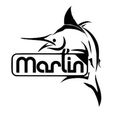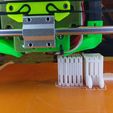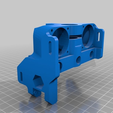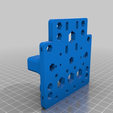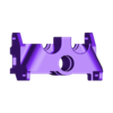This is to achieve 3 goals for me:
- A universal firmware with large community support
- Advanced features and controls
- Future proofing and improvements to come
For me Marlin meets these goals. I already posted a link to the firmware page but you will also need a few more things.
Once you have these things and have wired your printer up to the RAMPS board you need some firmware to control things. First step is to download Marlin from the website above. Extract the folder and install the Arduino IDE.
Inside the downloaded folder for Marlin you will find \Marlin-1.1.x\Marlin\example_configurations\Anet\A8. In that folder is two files Configuration.h and Configuration_adv.h. Copy these files into \Marlin-1.1.x\Marlin replacing what is there. This is the basic configuration for the Anet A8 and gets you started.
Now if you really want to download this thing in inside is my Configuration.h for my Anet A8 with my carriage from https://www.thingiverse.com/thing:2766701 and an 18mm inductive sensor with bilinear bed leveling. Just like above copy these files into \Marlin-1.1.x\Marlin overwrite what`s there. Then you can just tweak them to meet your needs. This might be the easiest route.
Open the Arduino IDE and browse to your downloaded Marlin files. Inside \Marlin-1.1.x\Marlin you will find Marlin.INO. This is the file you need to load into the Arduino IDE.
Inside the Arduino IDE you will see tabs across the top. Select the tab "Configuration.h" and start reading. There`s lots of comments to help you setup and understand what each line does but there are a few we will need to concentrate on.
The sample configurations assume a bone stock Anet A8 with stock carriage and all. You can just run with those if that is what you have.
First thing to change is the serial baudrate. This is set with the line #define BAUDRATE 115200 This is the stock setting for an Anet A8 and works just fine. If you encounter issues with dropped communication when printing consider slowing it down a little. #define BAUDRATE 57600 is the next slowest for example.
Next thing to set is your motherboard. In the tab "Boards.h" you will find a list of the boards and their codes. I use #define MOTHERBOARD BOARD_RAMPS_14_EEB because I have RAMPS 1.5 with Extruder, Extruder, Build plate heater connections. These corospond to the screw terminals marked D10, D9, D8 on the RAMPS board. So what we have set here is:
- RAMPS Motherboard
- D10 is extruder 0
- D9 is extruder 1
- D8 is heated bed
Now with this setting the firmware automatically moves the cooling fan PWM output to the SERVO section on the RAMPS board. The set of 3 servo pins furthest from the RAMPS power connector are what is used but be aware these pins are not meant to handle power. You will need to use a MOSFET between them and 12v to power the fans. I found inexpensive Arduino compatable MOSFETs on Amazon for a few dollars.
This must be set to #define MOTHERBOARD BOARD_RAMPS_14_EFB if you have a single extruder. This assigns the outputs to:
- RAMPS Motherboard
- D10 is extruder 0
- D9 is cooling fans
- D8 is heated bed
Next comes the #define CUSTOM_MACHINE_NAME "Your Name Here" line. This is just the name reported over serial and displayed in the printer ready message on the LCD screen. It can be set to about anything.
The next line sets the number of extruders. This goes with the motherboard setting above. #define EXTRUDERS 2 if you have 2, #define EXTRUDERS 1 for one, so on.
Next is the setting for filiment size. This is how the machine calculates how much to feed. Set it to 1.75 if that is what you are using, it is pretty much the standard though there are other sizes. #define DEFAULT_NOMINAL_FILAMENT_DIA 1.75 for 1.75.
A little further down is the next one to look at. If you have more than one extruder you need to remove the //s in front of both lines and set your offset. If single extruder leave this commented out.#define HOTEND_OFFSET_X {0.0, 35.00}and#define HOTEND_OFFSET_Y {0.0, 0.00}` is the setting for my dual extruder heads for example.
Theres a large block of text talking about thermal sensors. We might need to change this especially if you have dual extuders.#define TEMP_SENSOR_0 5` is for extruder 0 for example and tells the firmware you have a 100K thermistor type sensor. This is the most common type. I have the settings below set for my dual extruder carriage.
#define TEMP_SENSOR_0 5
#define TEMP_SENSOR_1 5
#define TEMP_SENSOR_2 - 4 are set to 0
#define TEMP_SENSOR_BED 5
I do not mess with the PID and thermal runaway settings. They seem fine.
Next section is endstop inverting. These all should be set to true.
#define X_MIN_ENDSTOP_INVERTING true
#define Y_MIN_ENDSTOP_INVERTING true
#define Z_MIN_ENDSTOP_INVERTING true
#define X_MAX_ENDSTOP_INVERTING true
#define Y_MAX_ENDSTOP_INVERTING true
#define Z_MAX_ENDSTOP_INVERTING true
#define Z_MIN_PROBE_ENDSTOP_INVERTING true
Next we have Distict E Factors. This lets you setup your dual extruders with differnt feed speeds. Uncomment the line #define DISTINCT_E_FACTORS to enable this if needed. I run two identical extruders so I left it commented out.
Following is the default axis steps per unit. The unit here is MM. This is an initial setting. I use LV8729 drivers on 1/32 microstepping. This means the following must be set here.
#define DEFAULT_AXIS_STEPS_PER_UNIT {200, 200, 800, 200}
If you are using 1/16th stepping you would set:
#define DEFAULT_AXIS_STEPS_PER_UNIT {100, 100, 400, 100}
Skipping ahead we come to the Z Probe Options. This is where you setup the probe for auto level.
The line #define Z_MIN_PROBE_USES_Z_MIN_ENDSTOP_PIN means the probe is connected to the same pins as the min Z switch was.
You can comment that line out and set the line below it #define Z_MIN_PROBE_ENDSTOP xx where XX is the Arduino pin number for where the probe signal goes.
Probe type is reffering to the mounting. All my heads use a fixed probe so set
#define FIX_MOUNTED_PROBE
Down from there is the settings for the offsets. Using my Front Sensor Carriage from https://www.thingiverse.com/thing:2766701 you would set:
#define X_PROBE_OFFSET_FROM_EXTRUDER 17
#define Y_PROBE_OFFSET_FROM_EXTRUDER -23
#define Z_PROBE_OFFSET_FROM_EXTRUDER -2.1
The last line is the difference in height between the extruder nozzle and the probe trigger point. We will come back to that.
I like to uncomment and turn on #define MULTIPLE_PROBING 2 to set it to probe each point twice. This is to make sure that it has an accurate reading.
Next few lines to tweak are the Z clearances. This is what tells the machine to lift up between probe points. I like to turn this on so I always clears.
#define Z_CLEARANCE_DEPLOY_PROBE 10 // Z Clearance for Deploy/Stow
#define Z_CLEARANCE_BETWEEN_PROBES 5 // Z Clearance between probe points
This means it will lift 10mm from the bed when it starts and stops probing and between each point it will lift 5mm before moving.
Down from there is the machine settings and motor inverting settings. This depends on how you wired it and the motor drives used. Mine is all backwards so I had to change these settings to what you see below. Keep in mind you might not have to.
#define INVERT_X_DIR true
#define INVERT_Y_DIR true
#define INVERT_Z_DIR false
#define INVERT_E0_DIR false
#define INVERT_E1_DIR true
The reason one is inverted and the other not is because of how I mounted them. Again this setting depends on many things and should be checked by carefully moving the printer once the firmware is flashed.
Down from there is the settings for the bed size.
#define X_BED_SIZE 220
#define Y_BED_SIZE 220
Then the travel limits. These are also known as Home Offsets and can be changed via terminal later. For my Carriage its:
#define X_MAX_POS 240
#define X_MIN_POS -10
#define Y_MAX_POS 225
#define Y_MIN_POS -13
#define Z_MAX_POS 230
#define Z_MIN_POS 0
These are also used for the software endstops.
Next we come to the Bed Leveling section. This is where you choose how and where to probe. I like to use Bilinear for it gives excellent results and is easy to run. You must add G29 to the start Gcode of your prints after it homes.
Uncomment the line #define AUTO_BED_LEVELING_BILINEAR to enable or choose what you think will be best for you.
You can choose how many points it probes with the settings
#define
GRID_MAX_POINTS_X 4
#define
GRID_MAX_POINTS_Y GRID_MAX_POINTS_X
This gives 4x4 or 16 probe points. Less is faster more is more precise. More than 7 though can cause performance and memory issues.
Once you choose one you must set where the probe can reach. For my front probe carriages on an Anet A8 it`s
#define LEFT_PROBE_BED_POSITION 30
#define RIGHT_PROBE_BED_POSITION 200
#define BACK_PROBE_BED_POSITION 190
#define FRONT_PROBE_BED_POSITION 20
As a part of this check and be sure that #define Z_SAFE_HOMING is enabled and not commented out. By default in the Marlin config for the Anet A8 it should be enabled.
Moving on to the Additional Settings section we come to Preheat Constants. Set your Preheat settings here. I like to run 50c on the bed and 200c on the extruders. It you have more than one extruder you must have more than one setting here like below.
Extruder 0:
#define PREHEAT_1_TEMP_HOTEND 200
#define PREHEAT_1_TEMP_BED 50
#define PREHEAT_1_FAN_SPEED 0 // Value from 0 to 255
Extruder 1:
#define PREHEAT_2_TEMP_HOTEND 200
#define PREHEAT_2_TEMP_BED 50
#define PREHEAT_2_FAN_SPEED 0 // Value from 0 to 255
Now to LCD and SD support. This is where you setup your LCD controller. I like to use the RAMPS compatible RepRapDiscount FULL GRAPHIC Smart Controller. This is also known as the 12864 LCD. A common issue with these is the knob goes the wrong direction. You change it with the line #define REVERSE_ENCODER_DIRECTION by uncommenting it.
From the list below that line uncomment the one that matches your controller. Using the same example that is #define REPRAP_DISCOUNT_FULL_GRAPHIC_SMART_CONTROLLER
That should be enough to get you going!
Now to compile. From the TOOLS menu in the Arduino IDE select your board. In this case it`s "Arduino/Genduino MEGA or MEGA 2560". Then select your COM port the board is connected to.
Click on the checkmark button at the top of the screen and the program will compile. This will take a few minutes and if there`s any issues it will tell you what they are in orange print in the black bar at the bottom of the screen. If all is well it will say "Done Compiling" and give you a summary of the memory usage.
With it compiled its time to upload. Hit the -> right arrow looking icon at the top with your board plugged in to USB and it will compile then upload. Once again you will get "Upload Complete" should it all work out fine and now its programmed.
From here you need to verify everything is moving in the right directions. Move your axis slowly to be sure. Once all tests pass try warming it up. Make sure the temperature probes are reporting right and everything else is working.
Assuming you use a probe to do Autoleveling you will need to set the Z offset. Here`s the easy route I found.
- Home all axis with G28
- Set the offset to 0 to start with M851 Z0 then send M500 and load with M501
- Move to the middle of the bed with G1 X110 Y110
- Turn off software endstops. This means your machine could potentially crash into the bed so be careful, M211 S0
- Place a bit of paper on the bed under the nozzle and preheat the machine. Bring it up to operating temperature and be careful! Don`t get burned.
- Lower the Z slowly until that bit of paper is lightly pinched between the bed and nozzle.
- Send command M114 to get the current position. You will see something like Recv: X:110.00 Y:110.00 Z:2.10 E:0.00 Count X:26000 Y:22000 Z:1680
- From that line take the Z position and add a - to the front for Z-2.1 in this example
- Set the offset with M851 Z-2.1 be sure to use your offset!
- BE SURE TO ENABLE SOFTWARE ENDSTOPS with M211 S1
- Save the setting with M500
- You can run a quick autolevel with G29 to make sure it all works.
In your slicer be sure to add the line G29 ;Autolevel to the start gcode under the line with G28 in it. This levels the printer at the start of each print. Great if your machines moves around like mine. I take it place to place.
That should be it, you now have auto leveling Marlin powered Anet A8. There`s a lot I glossed over but you can learn more from these links where I sourced this guide from.
Thank you! Like, share it with those who can benefit, yell at me in the comments if I got it wrong and enjoy!

/https://fbi.cults3d.com/uploaders/16051940/illustration-file/eaceefbf-dc37-4548-9c3b-ca48b47b477e/marlinfw.jpg)
